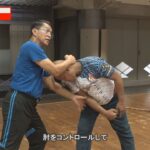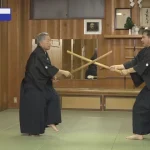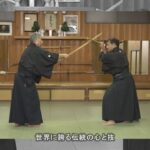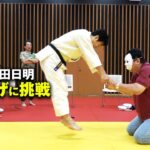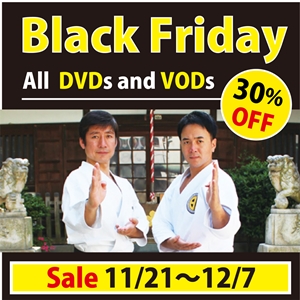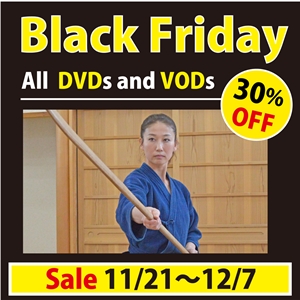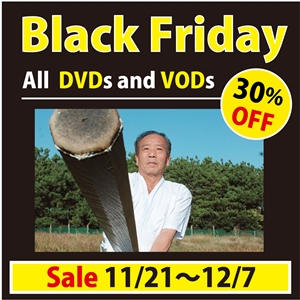An Interview with Former Sumo Wrestler, Takekaze Akira
“When I defeated the Yokozuna, it was less about strategy and more about giving 100% of everything I had.”
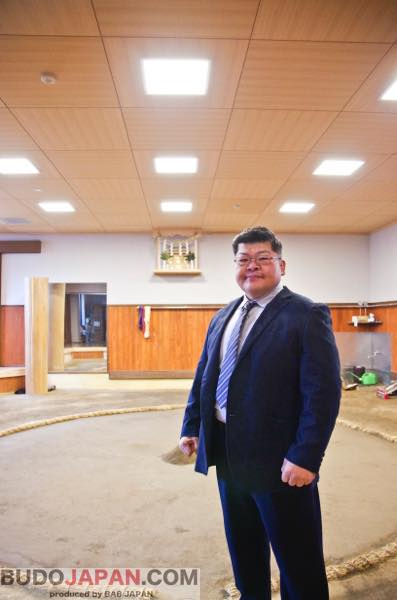
Oshiogawa Akira(Sekiwake Takekaze Akira)
Takekaze Akira, who climbed to the rank of sekiwake, the third-highest level in sumo, gracefully retired from the sport in 2019. This interview is drawn from a conversation that took place on December 9, 2023. I had first met Takekaze(*presently Oshiogawa Akira) earlier that year when I had the privilege of observing the morning training at his Oshiogawa sumo stable.
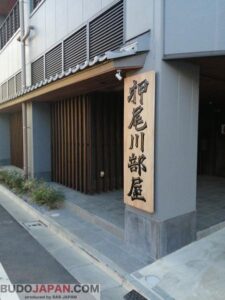
Oshiogawa sumo stable 1
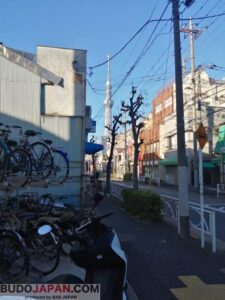
Oshiogawa sumo stable is located near the Tokyo Skytree.
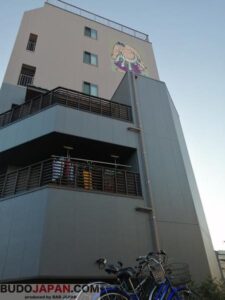
A painting of sumo wrestlers on the upper floor of the Oshiogawa stable building.
During that session, I couldn’t help but notice the similarities between Takekaze’s style of sumo and the kobudo techniques from my own traditional Japanese martial arts practice. Given sumo’s status as the foundation of martial arts in Japan, I was compelled to sit down with Takekaze for this article. Our conversation has been condensed and edited for clarity.
By Robert R. Gray
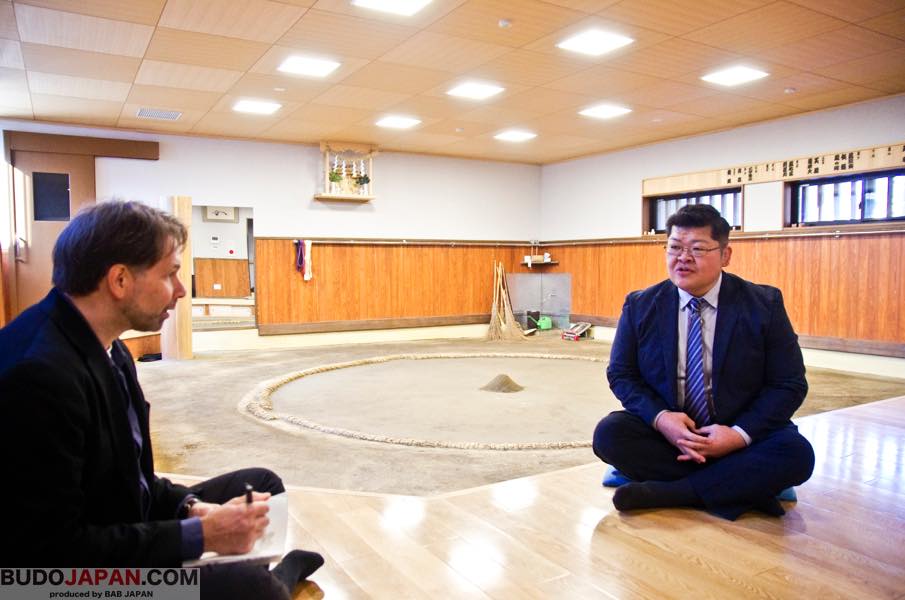
Robert.R.Gray and Oshiogawa Akira
joining a sumo stable
Gray: First, please tell me how you got started in sumo.
Takekaze: The first time I did sumo was at a tournament in my hometown. I was small and I had friends who were bigger than me who were practicing for the tournament. So, I started to try sumo just for fun, just playing around with my friends.
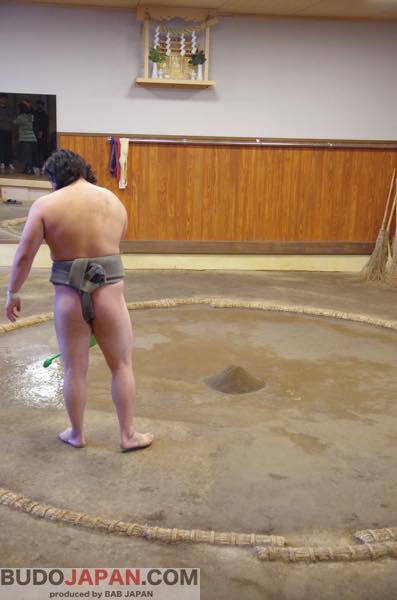
The sacred sumo ring(Dohyo)
Gray: How old were you when you entered a stable and started doing sumo seriously?
Takekaze: Twenty-two years old. I was twenty-two when I graduated from college and entered sumo.
Gray: What did your family think when you told them you were joining a sumo stable?
Takekaze: My family was against it. So, I had to push through their resistance in order to enter the sumo world. But, they’re my family and I think they were just anxious and worried about me.
Gray: So you started when you were twenty-two. What’s the youngest age someone can enter a stable?
Takekaze: Sumo wrestling starts at the age of 15. You have to complete your compulsory education and graduate from junior high school first. Then, you can enter. Although, in my case, I didn’t enter until I was a bit older.
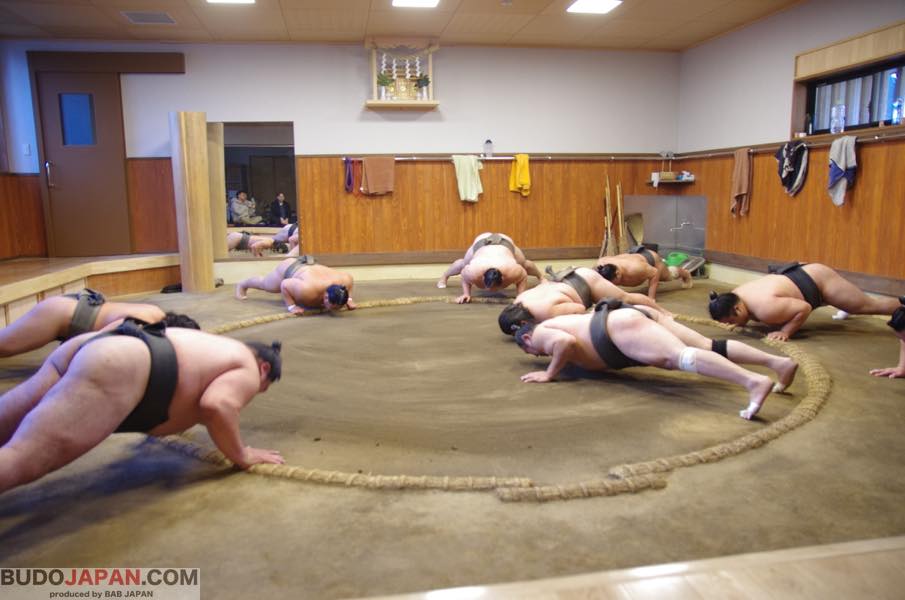
Beginning of the morning training
Gray: If a boy that age now is interested in becoming a sumo wrestler, what advice would you give him?
Takekaze: First of all, I’d check whether they are really committed or not, make sure it’s something they really wanted to do. Sumo is a very physical competition that involves hitting each other, so you have to have a strong spirit. Of course, you also need to develop your body and techniques, but if you don’t have a strong spirit, you won’t succeed. I like to educate and guide my student’s minds not only through training but also through doing chores and other work.
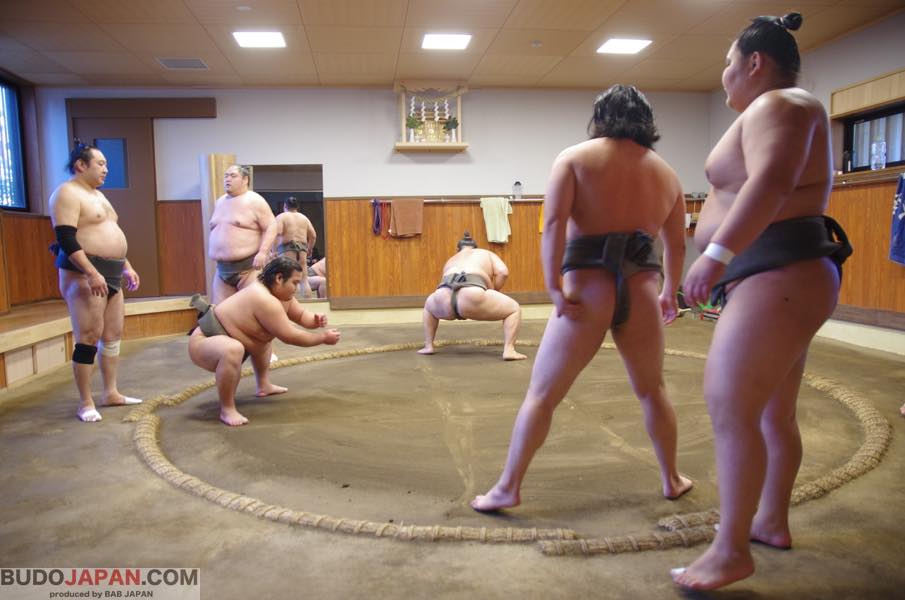
Suriashi training 1
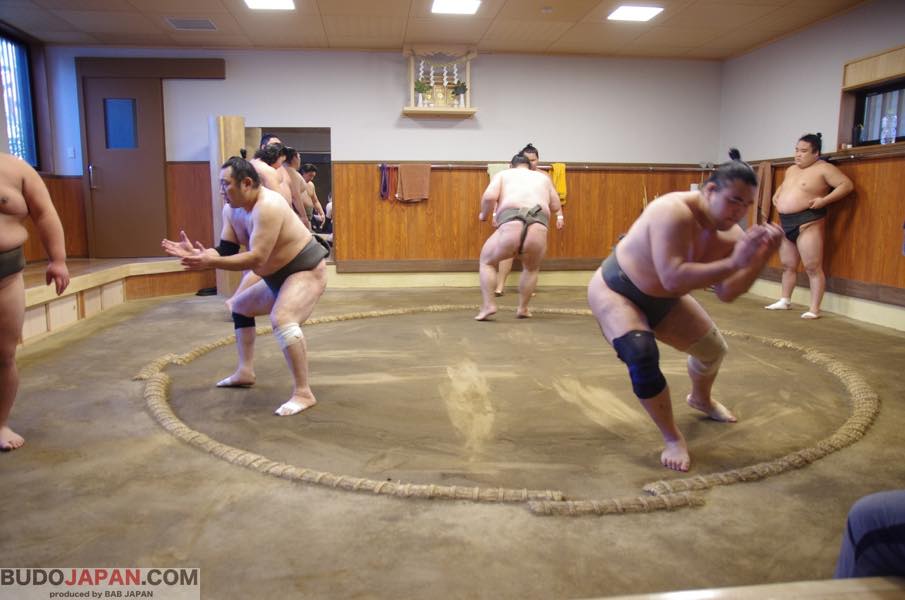
Suriashi training 2
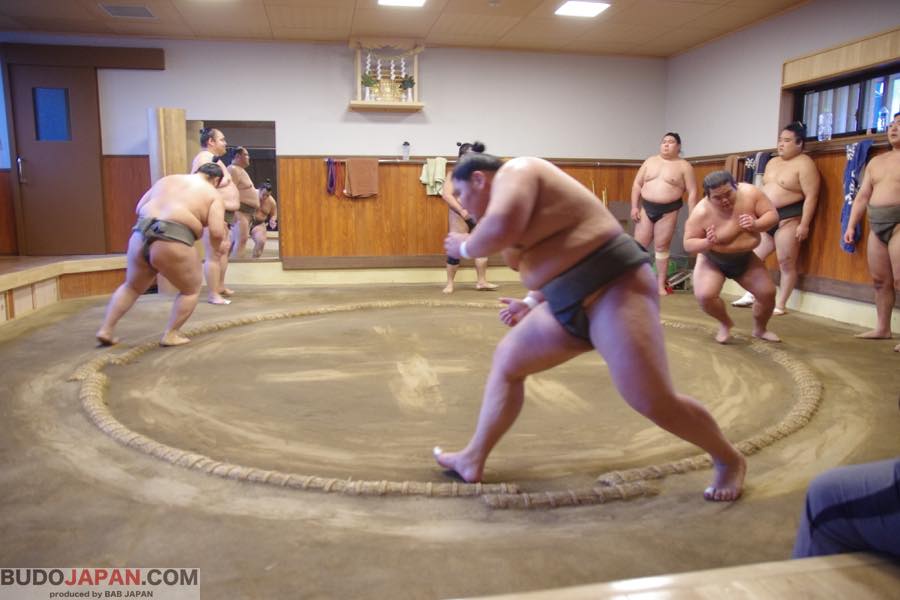
Suriashi training 3
Gray: For a boy like that who wants to enter sumo, is it better to enter as early as possible?
Takekaze: It depends on the child. If I had entered at the age of 15, for example, I would not have made it this far. It may look like I took a detour until the age of 22, but that detour was the best way for me. The path is different for each person. It’s hard to say in general.
Gray: What’s the most common pattern you see?
Takekaze: It’s often junior high school graduates, but there are also many who come from high school with experience through high school sumo.
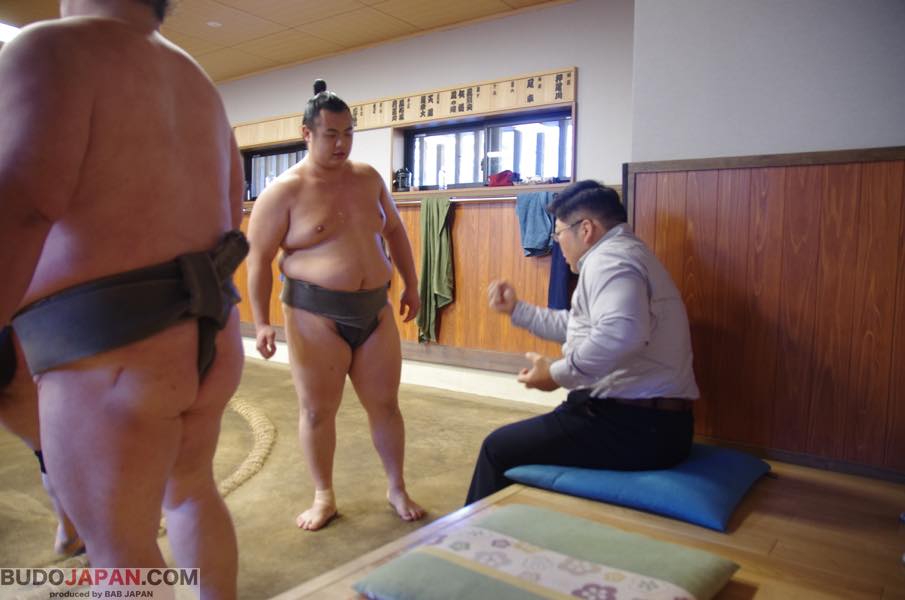
Oshikawa Oyakata instructs his apprentice.
giving 100% of everything I had
Gray: I understand that you reached the level of sekiwake. I’d like to ask you about your famous match when you won the kinboshi (gold star award given when a lower ranked sumo beats a yokozuna).
Takekaze: That was during the summer heat in Nagoya. Of course, I was happy. But more than that, the people around me, including the media and newspapers, made a lot of commotion about it. I was surprised. The more everyone else made a big deal about it, the less of a deal I made about it myself. Anyway, I thought I was doing a great job. I felt that sumo was a great thing.
Gray: Did you use any particular strategy against the Yokozuna at that time?
Takekaze: No, I had gone up against him a number of times before and lost. I just happened to win that time. So, I hadn’t been successful at making detailed strategies against him in the past. When I defeated the Yokozuna, it was less about strategy and more about giving 100% of everything I had. That was all I could do.
Gray: Another famous match was your win against Baruto. I happened to meet Baruto once and he was huge compared to me. Please tell me about that match.
Takekaze: That was at the Kyushu tournament and he was on the verge of moving up a rank to become an ozeki. People said many things about him, like he was a monster and so on, but he really had a bright personality. He was a cheerful person, and I thought that he was the kind of person who could become an ozeki. If I tried to make a detailed strategy, only about 60-70% of my power would come out. So, like I mentioned before, I felt that I should just give 100%, putting my trust in my training, rather than worry about some kind of strategy.
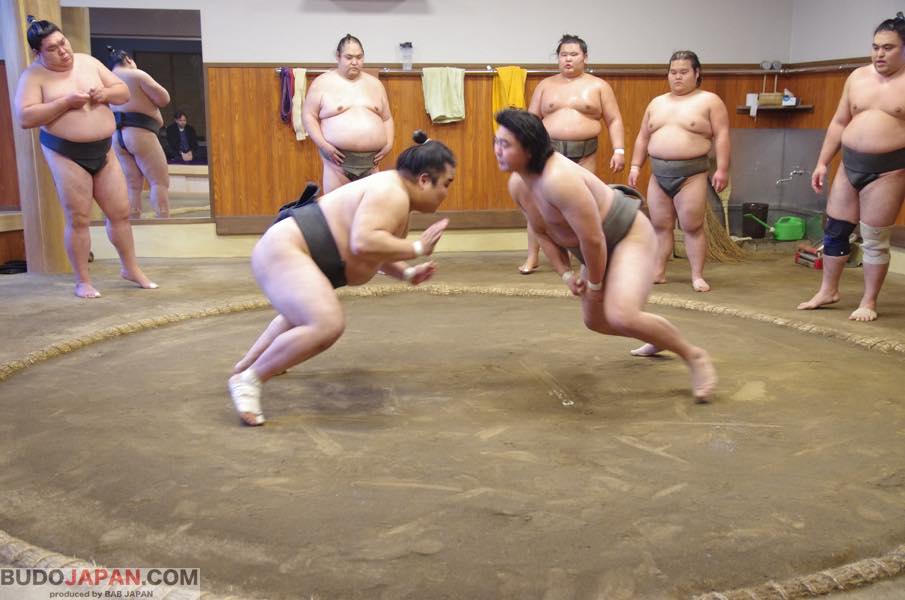
Moushiai training 1
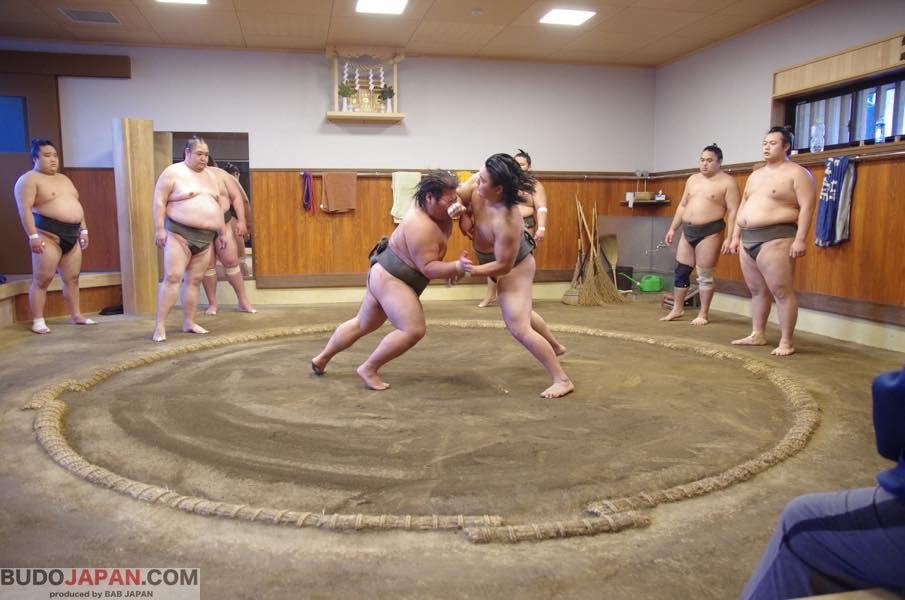
Moushiai training 2
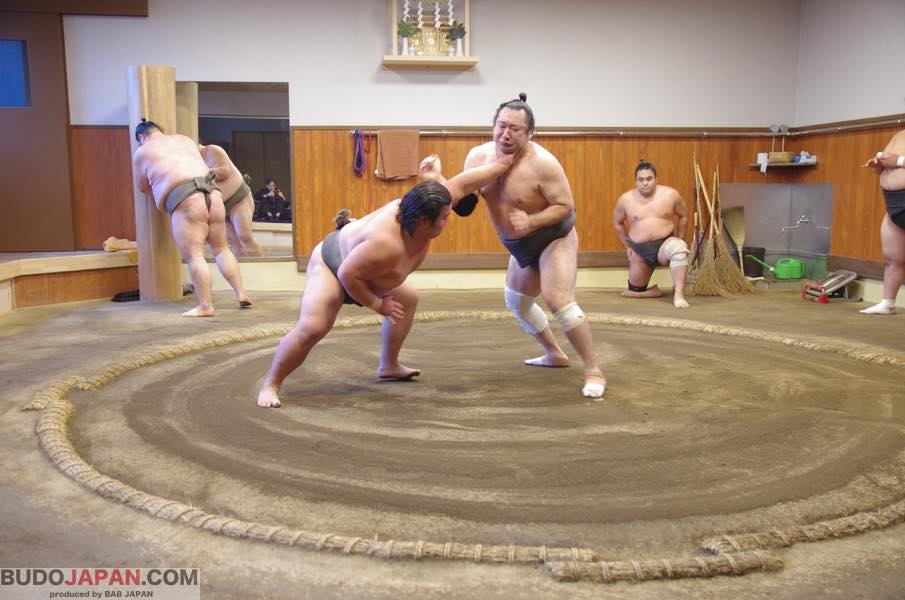
Moushiai training 3
“mushin” (a state of emptiness) of SUMO
Gray: One of the reasons I wanted to interview you was because I thought your movements and style were similar to the kobudo that I’ve been studying in Japan. For example, the way you lower your hips to gain an advantage and push larger opponents out of the ring. My kobudo teacher often emphasized the same thing about getting lower, and this kind of “oshi-sumo” seems to be your specialty. What is your approach to dealing with larger opponents?
Takekaze: I’m small for a sumo wrestler. Most of my opponents were bigger than me, so I needed to find a way to defeat larger opponents. My strategy, or rather, my power came from understanding my own strong points. When I thought about my strong points, I thought about how low I was and how fast I was. I also developed a lot of physical strength after entering sumo. I thought that if I developed the same amount of power as the bigger wrestlers, I could do well.
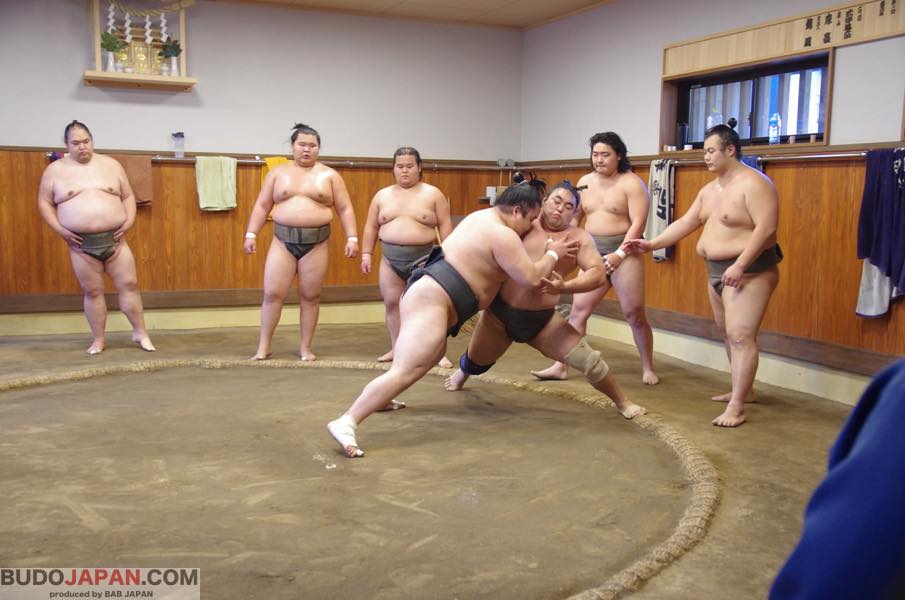
Gray: How did you develop your strength and power?
Takekaze: Through weight training, eating the right kind of food, and getting proper rest. Of course, we spend a lot of time practicing sumo, but weight training is important too. I don’t force this on my students however, saying, “Do it! Do it!” Instead, I want to make them want to do it. I explain that you should do it, or you’ll have regrets later.
Gray: The roots of traditional kobudo martial arts are said to be in sumo. What things do you feel they have in common?
Takekaze: Japanese archery is a part of kobudo. It’s very different than sumo, but even in archery, I think there is an element of soul or spirit that they have in common. It’s the idea of making yourself stronger, and polishing your spirit through training. Of course, sumo is sumo and it has its own unique characteristics. However, both sumo and kobudo start their practice with proper etiquette, or “rei” which means to be polite. I think many other martial arts also value this type of courtesy.
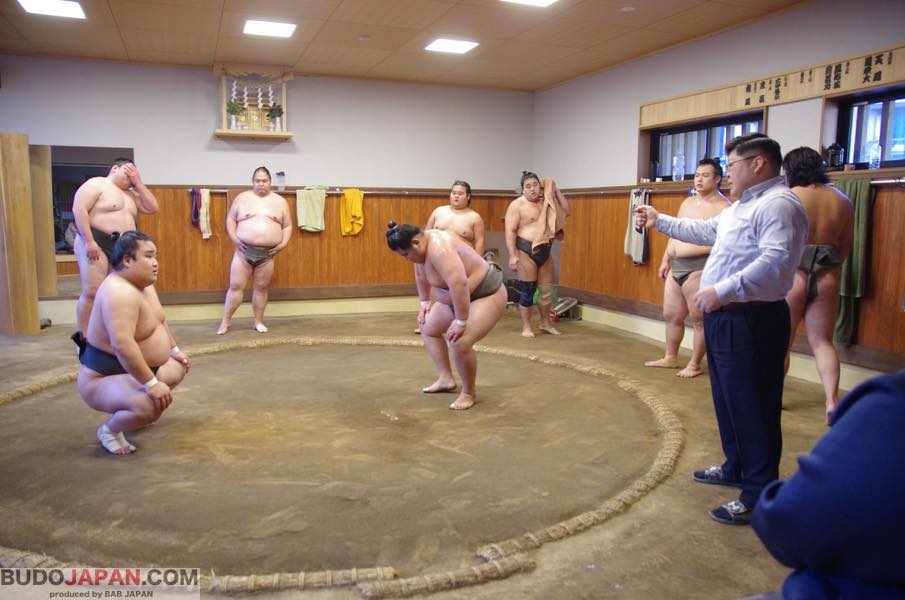
Gray: In various schools of kobudo, it’s said that “mushin” (a state of emptiness) is the highest state of mind. Is there a philosophy of mushin in sumo?
Takekaze: Nothing in particular, no. But in general, I do think that when you can become “mu” (empty or free from thought) it is the highest level to reach. However, if I tell my students about it now, they are not at that level yet, so I don’t think they would understand. When they think, “I want to win, I want to win, I don’t want to lose,” it is foolish. I think it’s important for them to eventually reach mu, but they won’t reach that point until they gain more experience.
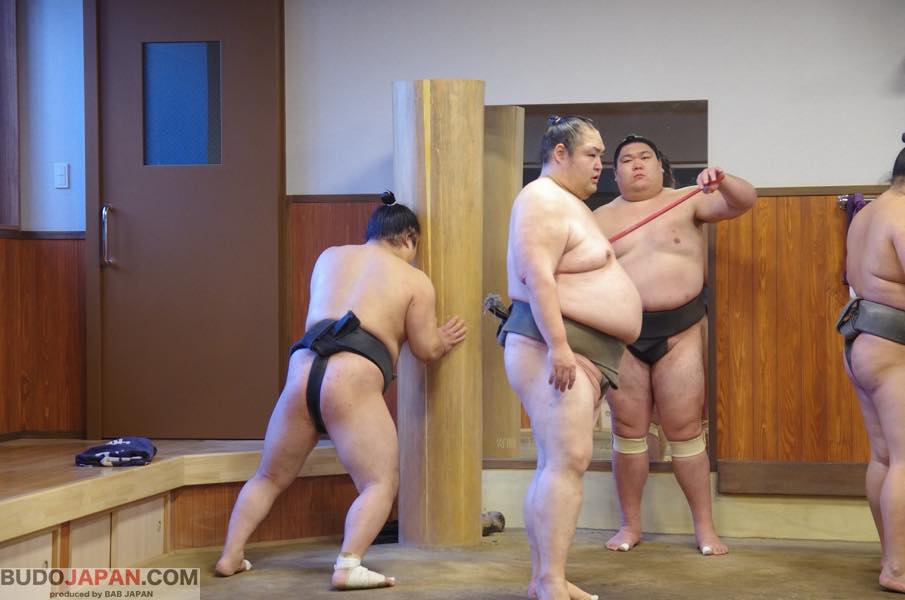
Teppo training
Gray: Have you felt or experienced mu during any of your sumo matches?
Takekaze: Yes, I have. There are various ways of describing or talking about it. Clearing your mind from thoughts of winning or losing is one way that gets close to mu; it approaches nothingness. Everyone wants to win—in a match, in life—but you have to go beyond that. I think this is the highest condition to reach. It is difficult.
typical day like for a sumo wrestler
Gray: What is a typical day like for a sumo wrestler?
Takekaze: It’s not just about the morning training. Development in sumo includes eating, meal preparation, chores, and so on. Even when you carry something, you lower your hips and carry it from the bottom. Everything becomes connected to sumo.
After the morning session, we have a break until 4:00 p.m. because the training can be tiring. At 4:00, we have cleaning time. Sand from the sumo ring sticks to our feet, so sand gets all over the place. We have to clean the floors, the hallways, the stairs, the toilets etc. Then, we have dinner at 6:00 p.m.
The same was true of the famous Yokozuna, Hakuho. He practiced sumo, but it was not just about wrestling. He also made a conscious effort in his daily life to be mindful of the way he walked and everything he did. It is not easy to raise your awareness to that high of a level. I think it is my role to help my disciples achieve such a high level of awareness. I think it is my job.
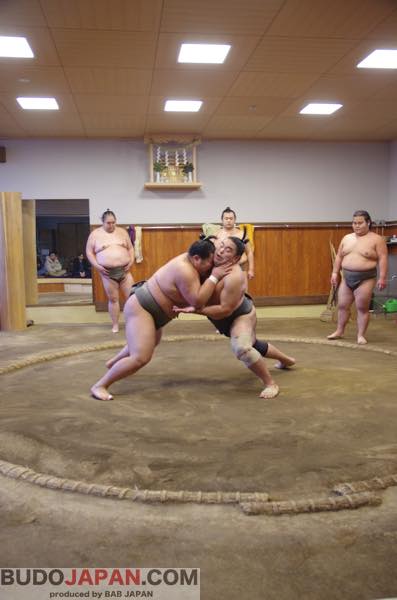
Gray: Does everyone live at this sumo stable?
Takekaze: Yes, everyone lives here. I have to see not only their training but also their eating, clothing, work and so on. If you’re the president of a company, you just watch over your employees while they’re at work. But here, I have to watch over everything else too. It’s hard work but they work hard because they are sumo wrestlers. That is what Japan is about. That is sumo. There is no greater joy or fulfillment than that.
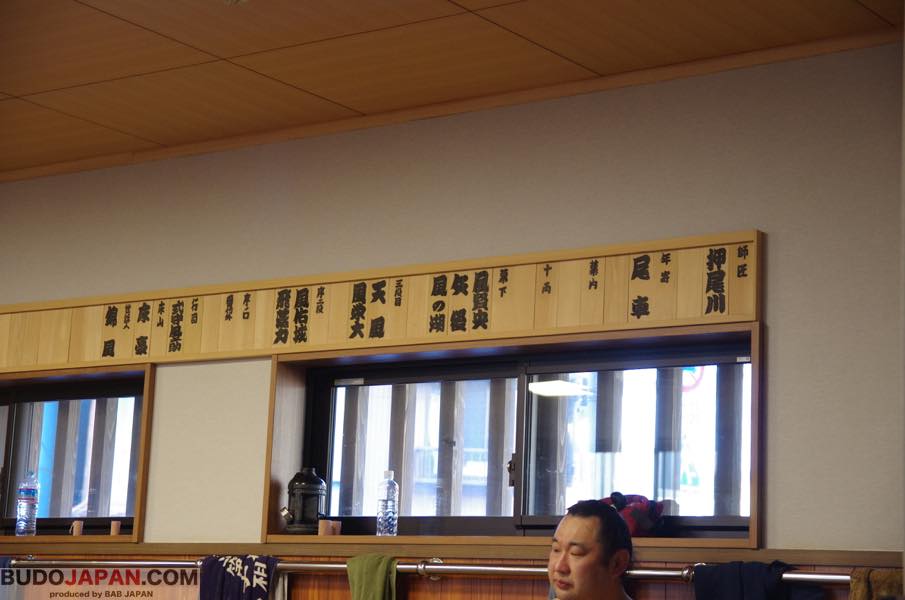
Gray: What are some of the advantages of that lifestyle?
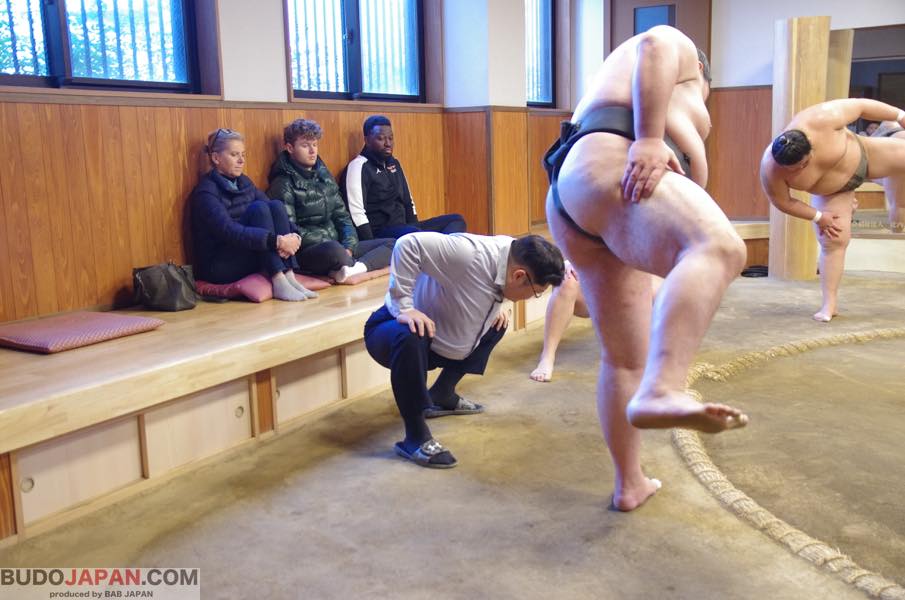
Shiko training 1
Takekaze: One of the advantages when I entered the sumo stable was that I got used to taking a nap. After lunch, sumo wrestlers usually take a nap for added rest, but I just couldn’t sleep during the day at first. I had a hard time with it and my recovery was weak. My body was sore, I caught colds easily, and I often had a sore throat. It took me about two years to get used to this way of living and get over those things.
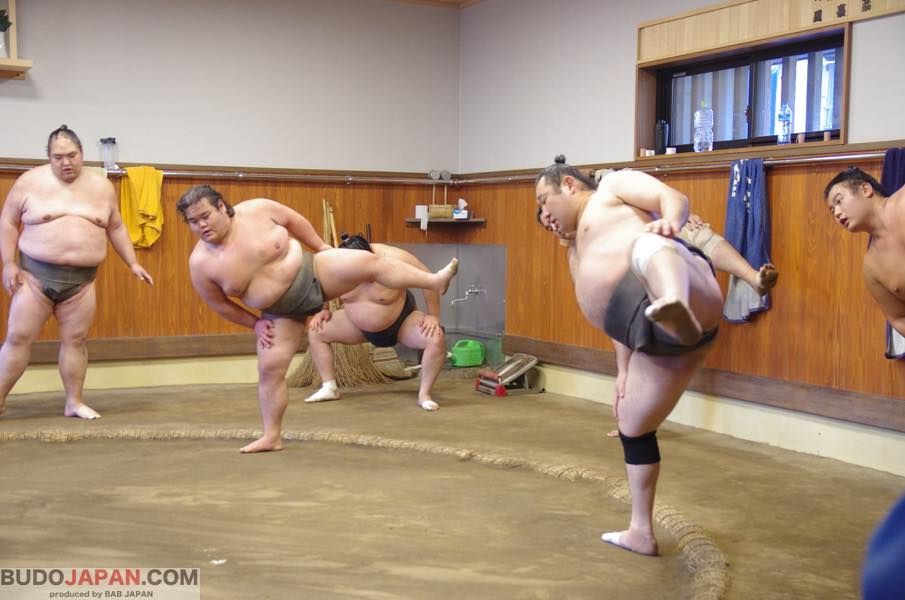
Shiko training 2
Gray: Recently on Netflix, a drama about sumo called “Sanctuary” has become popular. Have you seen it, and if so, what did you think about it?
Takekaze: Yes, I’ve seen it. The world in that show is not the real world of sumo. Of course, there are parts that dabble in sumo wrestling but it’s a different reality created for entertainment purposes. I thought it was interesting, though. I hope they continue it and make the next season.
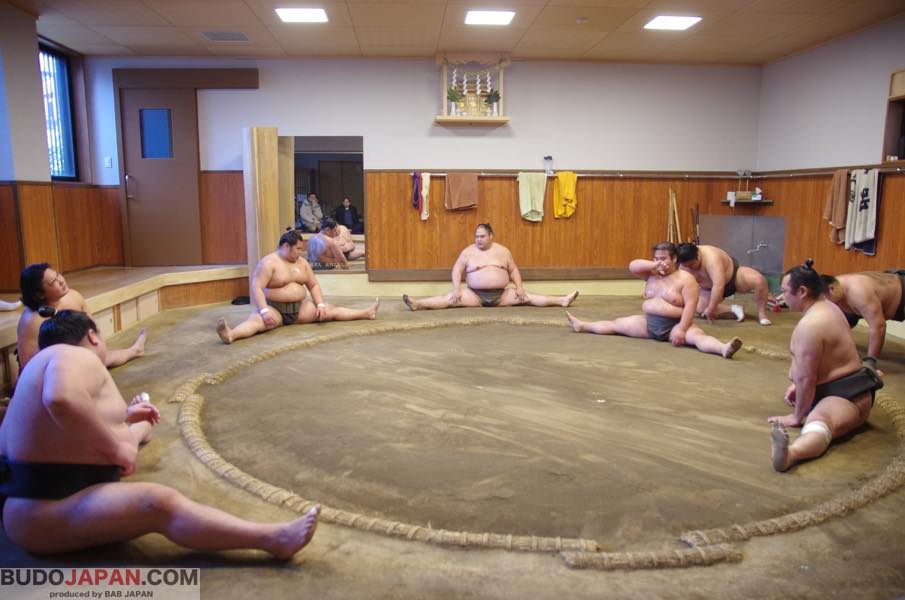
Matawari trainig 1
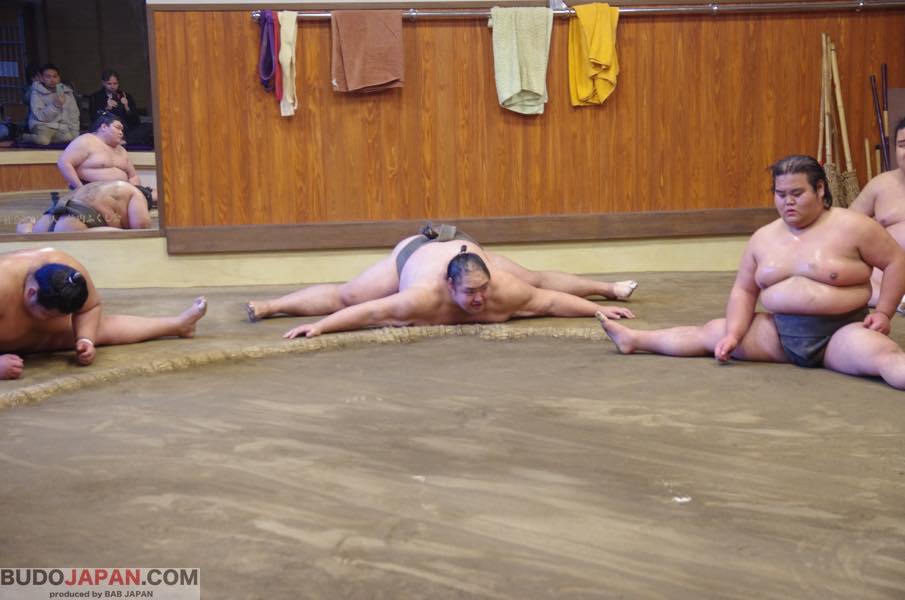
Matawari trainig 2
Gray: Were there any particular mistakes or misrepresentations you’d like to clarify for viewers of the show?
Takekaze: There were lots of misunderstandings in places and things that were different, but that is because it’s a drama. I didn’t watch it wanting to clear up misunderstandings, it’s just a whole different, fictitious world they created. It was entertaining in an unrealistic way.
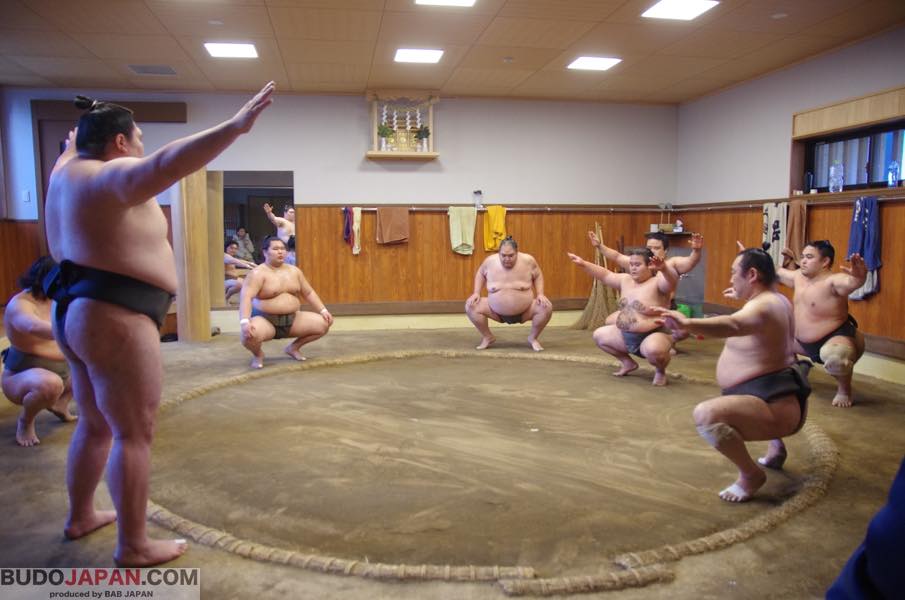
Finishing the morning trainig
Gray: Finally, is there anything else you’d like to say to the readers of Hiden Magazine?
This time, you featured me in your article on sumo, but I would like more people to become interested in and learn about Japan’s national sport. I think sumo has a lot in common with various other martial arts, so I hope that you will watch and become interested in sumo as well. We look forward to seeing you at Oshiogawa-beya this year.
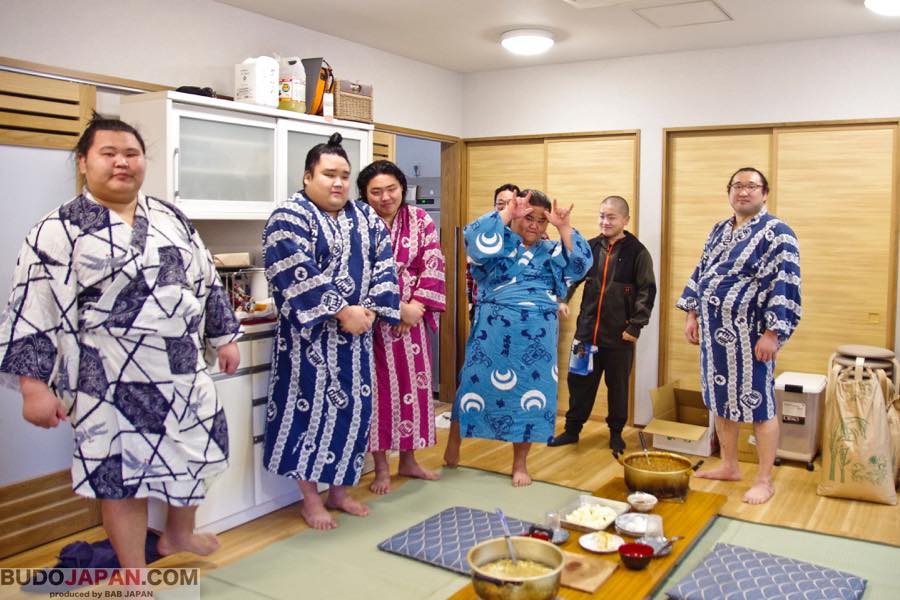
Chanko time(Sumo wrestler’s meal)






